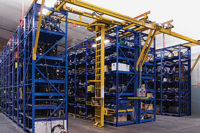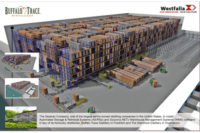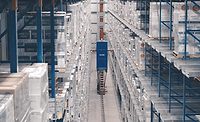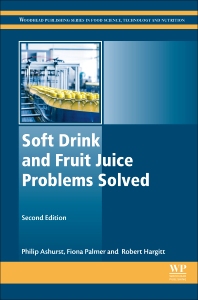AS/RS offer vertical storage solutions

Automated storage and retrieval systems like Newport News, Va.-based Swisslog Logistics Inc.’s Vectura line offer high-density storage for beverage-makers and distributors.

ITW Warehouse Automation, Arden, N.C., offers StorFast, a cart-based AS/RS.


Growing up, your mother probably reminded you to clean and organize your room, which seemed like a daunting enough chore, and you probably wished you had a robot to do it for you. Now, imagine having a whole warehouse full of a variety of products for you to organize and put away, which no doubt would be an even bigger chore, but this time having a machine to do it. As SKU proliferation continues, with new beverage products and packages demanding more space, organizing and finding room for everything in a warehouse or distribution center can be a challenge for industry professionals. Therefore, many beverage warehouses and distribution centers are turning to automated storage and retrieval systems (AS/RS) for automatic inventory organization and control.
According to Bill Daniel, director of business development for ITW Warehouse Automation, Arden, N.C., AS/RS have been popular in Europe for many years and are more recently becoming popular in U.S. warehouses. More companies are seeing that
AS/RS can help them grow their businesses by creating denser storage solutions, allowing more products in and enhancing warehouse efficiencies, he says. Plus, their automation aspect handles the work without need for human interaction.
“You kind of can look at [AS/RS] like a black box,” says Lonnie Watkins, strategic account manager of integrated systems at Dematic North America, Grand Rapids, Mich. “You bring product to it, and the AS/RS grabs that product and takes care of it.” Workers don’t have to worry about inventory once it’s in the system because the AS/RS will handle that for them, he says.
Featuring software that handles the organizational set-up of the storage system, the AS/RS decides where each new product should go so the user doesn’t have to make those decisions, Watkins says. However, Dematic’s AS/RS software is configurable for user parameters as well as velocity. For example, most beverage-makers want to send out their aged products sooner, so the system can be told to send that product out first, he says. Similarly, the software can be controlled with parameters for product weight and type. Parameters for product weight ensure that lighter items are placed on top and heavier items are placed toward the bottom. For product type, such as packaging or liquid product, parameters ensure that one product won’t leak on and damage another product or material, he adds. To achieve highest throughput velocity, the system organizes the most popular products in the front of the system, closest to the input/output site, so that the system does not have to move far distances up and down the aisles to store or retrieve the product, he says.
“What we really deliver is, we deliver long-term efficiency and performance for an up-front cost,” adds Bill Leber, director of business development for Swisslog Logistics Inc., Newport News, Va. “Due to equipment and software, a combination of those two things provide for a higher throughput with basically less people, less human interactions, [and] less hand-offs between people, and all of that improves your performance.”
Moving on up
Considering the increasing number of mergers and consolidations of distributors into one warehouse taking place in the beverage industry, utilizing AS/RS can increase storage capacity in a smaller space, Swisslog’s Leber says. Offering high-density storage, AS/RS utilize the vertical space.
The tallest AS/RS that Westfalia Technologies Inc. has installed is approximately 140 feet tall, but the company also has installed systems in buildings that are only 20 or 30 feet high, says Dan Labell, president of the York, Pa.-based company. Ranges of small and large systems can accommodate between 500 and 100,000 pallet rack positions, he says.
AS/RS solutions are custom-designed to fit each space using standard components when possible, Labell says. However, sometimes companies will “go greenfield” and choose to build a new, taller building to accommodate a taller AS/RS solution with more storage space, Dematic’s Watkins says. Because AS/RS allow buildings to expand upward instead of outward, companies can use the existing space above their heads to expand instead of buying more land to create a longer or wider building.
Whether a company chooses to go greenfield or brownfield, or optimize an existing building, AS/RS can be a heavy, up-front financial investment, Dematic’s Watkins says. “You’re probably looking at $7.5 million to get something in that you’ll be able to justify, and then it’ll go up to $40 [million] or $50 million, depending on the number of pallets you want to store.” These up-front costs sometimes are not an economical option for smaller distributors that only handle a few million cases each year, Swisslog’s Leber adds.
However, Dematic’s Watkins notes that bigger systems tend to pay back faster. “If you’ve got a system that’s $30 million for a pallet system, chances are pretty good you very likely have paid for that system before you even start it up, because the alternative is to build a flat warehouse and put a bunch of labor in it, and just the expense of building a 30- or 40-foot-high warehouse and putting a conventional rack in it, that expense alone may be more than what you spend on an automated system when you start talking about that many pallets of storage — and we’re talking, in this case, 50,000 or 60,000 pallets.”
Westfalia’s Labell agrees that AS/RS can be an economical option compared with other solutions and offer a worthwhile return on investment for manufacturers or distributors. “Drivers to help justify the use of AS/RS are high labor costs and labor reliability issues, space constraints, inventory accuracy, customer service levels as measured by on-time and accurate order fulfillment, reduced product damage, etc.,” he says.
Picking more than pallets
Although AS/RS operations offer fast, efficient storage and retrieval of products so that companies can complete shipments in a timely manner, demands for mixed pallet shipments by retail channels have challenged the industry to achieve the same efficiency with case handling.
“The bottom line is the stores — the liquor stores, the c-stores and all these guys — don’t want to store inventory, and the SKUs have grown so much in the space that they don’t have the room to store inventory,” Dematic’s Watkins explains. “So they’re expecting the distribution side of the supply chain to maintain inventory, and they want their product as real-time as they can get it so that it goes straight to shelf.”
Because of this, distributors and warehouses need to deliver smaller quantities of product more frequently while also offering a variety of product to suit the client’s needs, Watkins says. For this reason, he says that case-level AS/RS and the flexibility they offer may be the way of the future.
Case-level AS/RS are designed to assemble mixed-SKU orders for shipment, Watkins says. These systems break down full-pallet inventories and store them as individual cases of product. When it’s time to assemble a pallet for shipment, the system grabs a few cases of each product type, depending on the order, and prepares a rainbow, or mixed-SKU, pallet for shipment.
“When you talk about case-level AS/RS, I think it’s a huge opportunity in the beverage space,” Watkins says. “We’re not seeing SKU growth slow down. The number of products that are available today versus 10 years ago is almost unbelievable, and we think that trend is going to continue. And the more that they do that, and the more that the customers are demanding smaller, more frequent shipments, you are going to see mixed-SKU orders as a standard.” BI
Looking for a reprint of this article?
From high-res PDFs to custom plaques, order your copy today!









